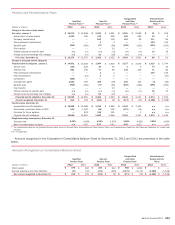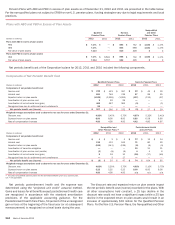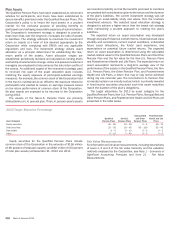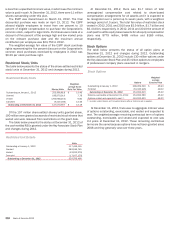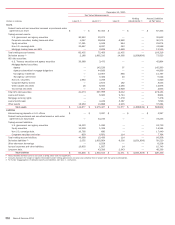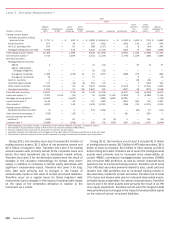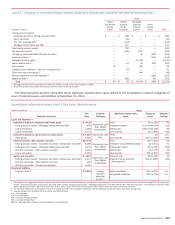Bank of America 2012 Annual Report Download - page 255
Download and view the complete annual report
Please find page 255 of the 2012 Bank of America annual report below. You can navigate through the pages in the report by either clicking on the pages listed below, or by using the keyword search tool below to find specific information within the annual report.Bank of America 2012 253
Management concluded that no valuation allowance is
necessary to reduce the U.K. NOL carryforwards and U.S. NOL and
general business credit carryforwards since estimated future
taxable income will be sufficient to utilize these assets prior to
their expiration. The majority of the Corporation’s U.K. net deferred
tax assets, which consist primarily of NOLs, are realizable by
certain subsidiaries that have a recent history of cumulative
losses. For the deferred tax assets of those subsidiaries, the
cessation of certain business activities, changes to capital and
funding, forecasts of business volumes and the indefinite period
to carry forward NOLs represent significant positive evidence
supporting management’s conclusion. However, significant
changes to those estimates, such as changes that would be
caused by a substantial and prolonged worsening of the condition
of Europe’s capital markets, could lead management to reassess
its U.K. valuation allowance conclusions.
At December 31, 2012, U.S. federal income taxes had not been
provided on $17.2 billion of undistributed earnings of non-U.S.
subsidiaries that management has determined have been
reinvested for an indefinite period of time. If the Corporation were
to record a deferred tax liability associated with these
undistributed earnings, the amount would be approximately $4.3
billion at December 31, 2012.
NOTE 21 Fair Value Measurements
Under applicable accounting guidance, fair value is defined as the
exchange price that would be received for an asset or paid to
transfer a liability (an exit price) in the principal or most
advantageous market for the asset or liability in an orderly
transaction between market participants on the measurement
date. The Corporation determines the fair values of its financial
instruments based on the fair value hierarchy established under
applicable accounting guidance which requires an entity to
maximize the use of observable inputs and minimize the use of
unobservable inputs when measuring fair value. There are three
levels of inputs used to measure fair value. The Corporation
conducts a review of its fair value hierarchy classifications on a
quarterly basis. Transfers into or out of fair value hierarchy
classifications are made if the significant inputs used in the
financial models measuring the fair values of the assets and
liabilities became unobservable or observable, respectively, in the
current marketplace. These transfers are considered to be
effective as of the beginning of the quarter in which they occur.
For more information regarding the fair value hierarchy and how
the Corporation measures fair value, see Note 1 – Summary of
Significant Accounting Principles. The Corporation accounts for
certain financial instruments under the fair value option. For more
information, see Note 22 – Fair Value Option.
Valuation Processes and Techniques
The Corporation has various processes and controls in place to
ensure that fair value is reasonably estimated. A model validation
policy governs the use and control of valuation models used to
estimate fair value. This policy requires review and approval of
models by personnel who are independent of the front office, and
periodic re-assessments of models to ensure that they are
continuing to perform as designed. In addition, detailed reviews
of trading gains and losses are conducted on a daily basis by
personnel who are independent of the front office. A price
verification group, which is also independent of the front office,
utilizes available market information including executed trades,
market prices and market-observable valuation model inputs to
ensure that fair values are reasonably estimated. The Corporation
performs due diligence procedures over third-party pricing service
providers in order to support their use in the valuation process.
Where market information is not available to support internal
valuations, independent reviews of the valuations are performed
and any material exposures are escalated through a management
review process.
While the Corporation believes its valuation methods are
appropriate and consistent with other market participants, the use
of different methodologies or assumptions to determine the fair
value of certain financial instruments could result in a different
estimate of fair value at the reporting date.
During 2012, there were no changes to the valuation
techniques that had, or are expected to have, a material impact
on its consolidated financial position or results of operations.
Level 1, 2 and 3 Valuation Techniques
Financial instruments are considered Level 1 when the valuation
is based on quoted prices in active markets for identical assets
or liabilities. Level 2 financial instruments are valued using quoted
prices for similar assets or liabilities, quoted prices in markets
that are not active, or models using inputs that are observable or
can be corroborated by observable market data for substantially
the full term of the assets or liabilities. Financial instruments are
considered Level 3 when their values are determined using pricing
models, discounted cash flow methodologies or similar
techniques, and at least one significant model assumption or input
is unobservable and when determination of the fair value requires
significant management judgment or estimation.
Trading Account Assets and Liabilities and Available-for-
sale Debt Securities
The fair values of trading account assets and liabilities are primarily
based on actively traded markets where prices are based on either
direct market quotes or observed transactions. The fair values of
AFS debt securities are generally based on quoted market prices
or market prices for similar assets. Liquidity is a significant factor
in the determination of the fair values of trading account assets
and liabilities and AFS debt securities. Market price quotes may
not be readily available for some positions, or positions within a
market sector where trading activity has slowed significantly or
ceased. Some of these instruments are valued using a discounted
cash flow model, which estimates the fair value of the securities
using internal credit risk, interest rate and prepayment risk models
that incorporate management’s best estimate of current key
assumptions such as default rates, loss severity and prepayment
rates. Principal and interest cash flows are discounted using an
observable discount rate for similar instruments with adjustments
that management believes a market participant would consider in
determining fair value for the specific security. Other instruments
are valued using a net asset value approach which considers the
value of the underlying securities. Underlying assets are valued
using external pricing services, where available, or matrix pricing
based on the vintages and ratings. Situations of illiquidity generally
are triggered by the market’s perception of credit uncertainty
regarding a single company or a specific market sector. In these
instances, fair value is determined based on limited available
market information and other factors, principally from reviewing
the issuer’s financial statements and changes in credit ratings
made by one or more rating agencies.


